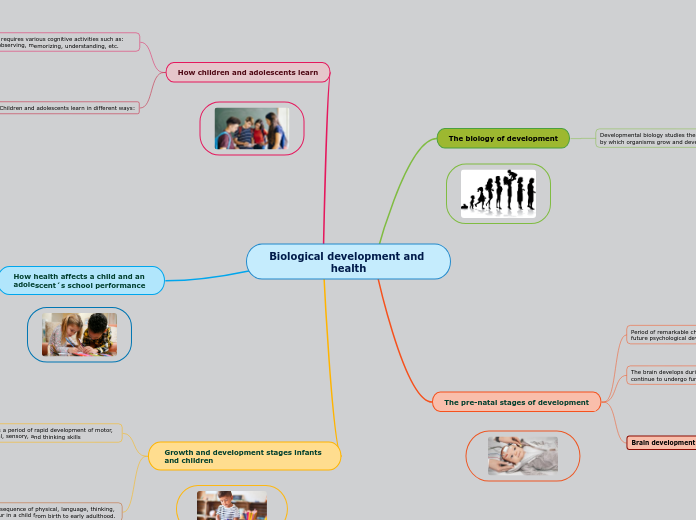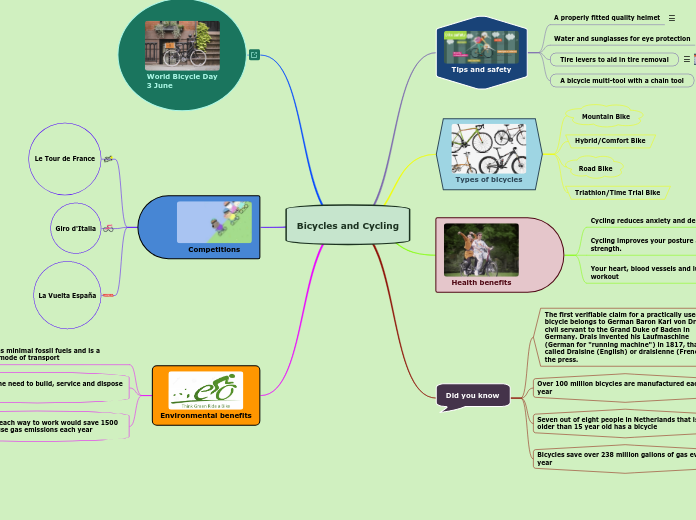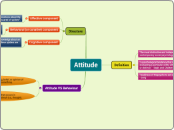Children's teachers need to personalize and contextualize content using examples related to their real life and according to the stage of learning.
Establish routines
Correct their mistakes in a positive way, and that children need to repeat the language many times.
Type of interaction you prefer, your motivation and interests, the time of concentration
Biological development and health
Growth and development stages infants and children
Child development refers to the sequence of physical, language, thinking, and emotional changes that occur in a child from birth to early adulthood.
During this process:
The child goes from dependence on his parents to greater independence.
Child development is influenced by genes passed on by parents, events during prenatal life, the environment, and the ability to learn
The first year is a period of rapid development of motor, language, social, sensory, and thinking skills
Child development covers the following skills:
Sensory awareness: recording sensory information for use (Kid sense)
Physical skills: fine motor skills (fingers) and gross motor skills (whole body)
Speech and language: understanding and use of language, reading and communication.
Social interaction and emotional regulation: interacting with others and mastering self-control
Cognition: the ability to learn and solve problems.
How health affects a child and an adolescent´s school performance
There are factors to consider in order to be in good health. Are genetics, environment, relationships with friends and family, and level of education and income.
The relationship between school performance and various health problems includes the following:
Chronic health problems: Diseases such as diabetes, epilepsy, cancer, hemophilia, congenital heart conditions, and HIV can affect children's school attendance and performance
Asthma. Children with this disease are at risk of poor academic performance due to acute exacerbations of the disease
Obesity: It is associated with an increase in type 2 diabetes, hypertension, sleep apnea, asthma, fat-releasing disease, cancer, psychological problems etc
Importance of breakfast: some students do not eat enough food and this can affect learning ability
A healthy breakfast is an effective means of improving academic performance and cognitive functioning.
Exercise: Physical activity helps children develop social skills, improve mental health, and is associated with fewer risky behaviors.
Improves cognition, mood, attention, and academic performance
Poor sleep: such as poor sleep patterns, resistance to going to bed, snoring, sleep apnea, and daytime sleepiness. Bad sleep = bad grades.
How children and adolescents learn
Children and adolescents learn in different ways:
Personality
Learning styles
Age
Learning at school requires various cognitive activities such as: paying attention, observing, memorizing, understanding, etc.
Children go through the following stages of learning:
At the age of 12 reason and test your ideas
More than 7 can reason and think, but are less focused and can look outside of themselves.
A baby or a baby who learns through the senses 2-7 years
Development of the ability to reason and think.
The pre-natal stages of development
Brain development before birth
The development of the human brain begins in the third week of gestation and lasts until at least the end of adolescence.
Two processes that contribute to brain development:
Impact of the environment.
They are essential for normal brain development, and disrupting any of them can fundamentally alter neural outcomes.
These processes interact to support events that outline brain development, both gene expression and environmental information.
Molecular events (gene expression)
The brain develops during the prenatal period, but it will continue to undergo further changes in early childhood.
It occurs in three main stages:
Fetal period
Embryonic period
Germinal stage
Period of remarkable change that helps lay the foundation for future psychological development.
The biology of development
Developmental biology studies the processes by which organisms grow and develop.
Teenager
Transitional period between childhood and adulthood The timing and speed with which these changes occur vary due to genetics and environment.
The changes that occur during this period are
Social
Of personality
The adolescent frontal lobe responsible for judgment, drive, control, and planning is still maturing.
Intellectual ans Psychology
Increase in risk behaviors and elevated emotions during this period
Physical development
Women have an early growth spurt
In males, growth is slower but they reach accelerated growth when they reach mature age.
Childish
They help to understand how children's formative experiences are carried out in their environment and help educators to understand the complexity and importance of their role
There are four general understandings of the role of the developing brain and other systems in early childhood development.
The interplay of genes and environment.
Neither environment nor biology alone is destiny.
Genes and environmental factors and experiences influence the child development.
Individual differences in sensitivity to surroundings.
Individual differences can affect the environment of susceptible children.
The impact of stress on development
The immune and endocrine systems may be affected by stress.
Early psychological and social adversities that begin during fetal development can have significant short- and long-term effects on brain development.
Rapid brain development during early childhood
The brain develops through the interaction of genes and the environment.









